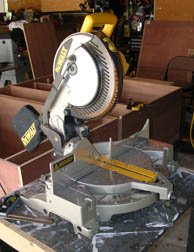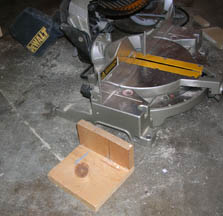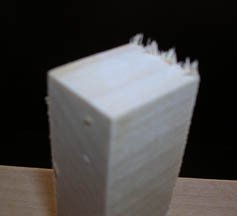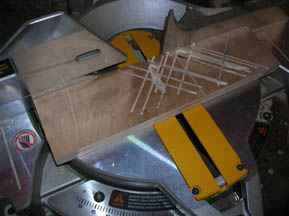|
Chop Saw (also known as: Miter Saw)"At least I use this one!" Or so said the chop saw owner to his wife who just didn't appreciate the value of his tool. 
As beginning woodworkers, we often start out shooting ourselves in the confidence foot by buying cheap tools in hopes that we can get by on sheer force of will. Think about those cheesy plastic miter box/back saw combos we've all fought with. They get easier to use if you clamp the box down. They get easier still if you clamp the stock as well. Jeez, get a chop saw. Otherwise known as a miter saw, this is one tool that will perform well beyond your initial thoughts. Look, imagining the uses for a table saw is easy. Something so small as a chop saw is different. "OK," you might say, "I can see how it cuts a variety of angles in short and long pieces of wood, but then what?" Well, once you get beyond the very basic birdhouse/spice rack projects, angles become the name of the game. Think crown/base moldings, frames of all sorts, or trim pieces. Get one, use it, you'll see. Most saws will come in the 10-inch size. Ours happens to be a DeWalt and has proven most useful. We have the pull-down version and often wish we had waited long enough to afford the sliding-blade type. What that type does is add greater flexibility to the width of board you can cut. Of course, it's also twice the price. As it stands, we are currently limited to about 6 inches. That's short by any number of measures. 
When cutting long pieces, it will be helpful to have a support that can hold the piece equal in height to the saw platform. We built ours out of scrap material. Interestingly enough, of all the stuff that seems to grow legs and wander off, this support piece has been with us as long as our chop saw. It gets as far away as 15 feet without complaint. Another shop-built support tool is a simple scrap piece of tossable wood. There's a phenomena called tear out. It's the result of a saw blade pressing against the wood grain. When the blade pushes the grain away as opposed to cutting through it, you get tear out. That fuzzy picture at right is tear out. Oh, it gets worse. But you get the idea. Place that tossable (scrap) piece under the one you are cutting to reduce tearout. 
To solve this problem, simply set a piece of scrap wood under the piece you are cutting. A chop saw blade cuts on the downward stroke, moving away from you. This presses the tear out at the bottom of the board. By placing a scrap piece under for support, your wood is cut cleanly while the support piece absorbs the tear out. After awhile, throw that support piece away and get another. Experience alone will make you comfortable with the this powerful tool. Each saw is slightly different. All have a movable base allowing you to cut a variety of angles from -45 to +45 degrees. They will also allow you to tilt the blade from 90 to whatever degrees (depending on manufacturer). 
For tiny increments of material removal, leave the saw off and push your wood against the stopped blade (in down position). Then pull the trigger and raise the blade. You'll take off a very small amount of material (the half-width of a half-blade). Some folks mount their chop saws on a long table. West Hills Wood hasn't done this yet but sure wish we could get around to it.
|
